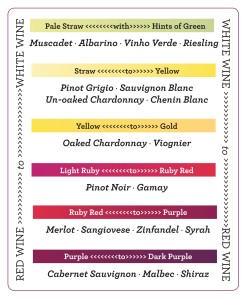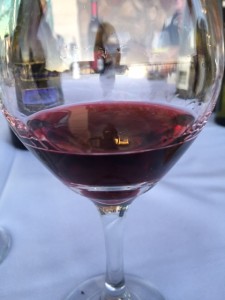Color Counts
 How many of you pay attention to the color of the wine in your glass? Often, the first instinct is to smell the wine and then quickly move on to tasting. But the color and appearance of the wine can tell us so much! In terms of color, wine is described so simplistically – red, white, or rosé. As we all know, there are virtually infinite shades of red that can range from rich garnet to ruby to deep purple to nearly black. Sometimes wines are tinged with a bit of brown or orange. And white wines aren’t really white – they are pale straw colored, gold, deep gold, or sometimes show a hint of green.
How many of you pay attention to the color of the wine in your glass? Often, the first instinct is to smell the wine and then quickly move on to tasting. But the color and appearance of the wine can tell us so much! In terms of color, wine is described so simplistically – red, white, or rosé. As we all know, there are virtually infinite shades of red that can range from rich garnet to ruby to deep purple to nearly black. Sometimes wines are tinged with a bit of brown or orange. And white wines aren’t really white – they are pale straw colored, gold, deep gold, or sometimes show a hint of green.
Some of us immediately judge a wine by its color. The pale red of some Pinot Noir’s might be seen as weak in flavor and a deep gold Chardonnay might be perceived as heavily oaked or too old without even smelling or tasting the wine. Most white wines darken with age and red wines may become lighter, as in the case of older Cabernet Sauvignons that may change over time from crimson to brick. The best way to look at a wine’s color is to hold the glass at a 45 degree angle and look down and across the surface.
There are other visual elements such as the texture or viscosity of wine and clarity. Everyone has  swirled wine around in the glass and looked for the “legs”, or the way the wine coats the sides of the glass. This is caused by the evaporation of alcohol. The higher the alcohol content, the slower the evaporation and the more viscous the wine. If you were poured a wine that was deep red in color and highly viscous, it might be a Zinfandel as this varietal is typically higher in alcohol. Wine making techniques today are so sophisticated, the clarity of wine is almost assured, but there are some wine makers who prefer unfiltered wines and in this case, the wine may not be crystal clear. Another visual tip is the presence of sediment which is most likely to be found in red wines older than ten years. This is why decanting is usually recommended for older wines so that you don’t end up with some unexpected “mud” in your glass or in your mouth. Harmless, but not enjoyable!
swirled wine around in the glass and looked for the “legs”, or the way the wine coats the sides of the glass. This is caused by the evaporation of alcohol. The higher the alcohol content, the slower the evaporation and the more viscous the wine. If you were poured a wine that was deep red in color and highly viscous, it might be a Zinfandel as this varietal is typically higher in alcohol. Wine making techniques today are so sophisticated, the clarity of wine is almost assured, but there are some wine makers who prefer unfiltered wines and in this case, the wine may not be crystal clear. Another visual tip is the presence of sediment which is most likely to be found in red wines older than ten years. This is why decanting is usually recommended for older wines so that you don’t end up with some unexpected “mud” in your glass or in your mouth. Harmless, but not enjoyable!
Look at your next glass of wine in a whole new light.
Cheers!

 Lisa Gorham
Lisa Gorham
Interesting article!
I’m getting thirsty…